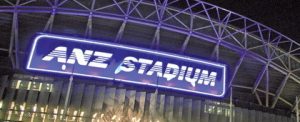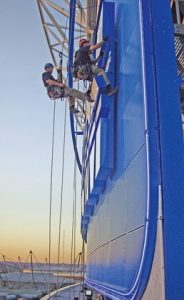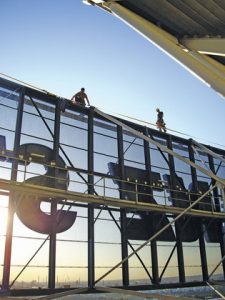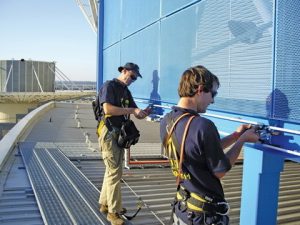Built in 1999, in anticipation of the following year’s 27th Olympiad, Sydney’s ANZ Stadium was known as Stadium Australia for its first three years before Telstra, a telecommunications provider, acquired naming rights for five years. How-ever, when Telstra relinquished naming rights to ANZ, one of Australia’s largest financial institutions, in December 2007, yet another rebranding was required.
As with any undertaking for a stadium that seats approximately 82,000 fans, who crowd the stadium to watch rugby, cricket and Australian football, it was hardly a small project. ANZ and stadium officials hired Claude Neon (Sydney), which had previously built the stadium’s Telstra-branded signage. The stadium’s primary ID signs comprised two, 30 x 138-ft. signs.
In addition to changing the name on the signs, Claude Neon also updated their light sources, according to Kirsty Dollisson, the company’s group-marketing director. Their team specified a combination of interior, 6,000K, white Tridonic Atco (Kingsgrove, NSW, Australia) LEDs – the sign employs 2,702 modules, with three diodes per module – and approximately 800 linear ft. of Tecnolux (Brooklyn, NY) brilliant-blue, exposed neon that provides the signs’ border tubing, and eight, “Hollywood-style,” Clay Paky (Seriate, Italy) LED floodlights that bathe the signs with accent lighting. The 13-ft.-tall letters have earned the distinction of being the tallest LED-lit channel letters in Australia, Dollisson said.
“After considerable research, the project team determined this neon/LED mix would provide the ideal balance of visual intensity, cost effectiveness and environmental sustainability,” she said.
Advertisement
Dollisson said the use of LEDs, in lieu of neon, as the primary lightsource reduced operating costs by 47% and reduced CO2 emissions by 34 tons annually. The LED floodlights also emit less heat and consume less energy than incandescent or halogen strobe lights. At a cost of 5.7 cents per kWh, Dollisson said this equated to an annual savings of $1,942 Australian dollars ($1,859 USD).
Claude Neon situated the signs against the 3mm-thick, perforated aluminum background mesh that had supported the previous sign. Custom brackets, engineered to strict tolerance to fit the existing steel framework, bolstered the new signs’ additional heft. Also, the rebranding required repainting the background with ANZ’s signature, azure-blue tone. Rappelling painters applied two coats with long, nap rollers.
To ensure the LEDs provided even lighting over such a ponderous surface, Claude Neon developed a series of scaled prototypes to maximize placement and viewing angle.
Also, incorporating the animated watermark that looms prominently on the company’s logo proved difficult. The company considered numerous alternatives that varied from illuminated, acrylic panels to animated neon. To convey this effect, the team ultimately conglomerated internal, channel-letter illumination, flood lights and programmed spotlights.
Advertisement
Lifting the letters into place required 50-ton cranes, and the letters were secured via ropes into pre-drilled holes. Because the signs outsized their predecessors, Claude Neon undertook rigorous onsite testing and engineering to ensure a strong support structure and sufficient lighting and components.
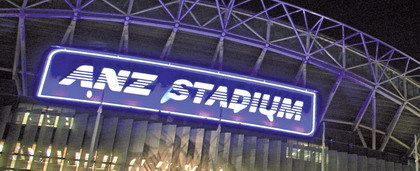

 Photo Gallery1 week ago
Photo Gallery1 week ago
 Ask Signs of the Times1 week ago
Ask Signs of the Times1 week ago
 Paula Fargo5 days ago
Paula Fargo5 days ago
 Real Deal2 days ago
Real Deal2 days ago
 Benchmarks2 weeks ago
Benchmarks2 weeks ago
 Photo Gallery5 days ago
Photo Gallery5 days ago
 Women in Signs1 week ago
Women in Signs1 week ago
 Women in Signs1 week ago
Women in Signs1 week ago
